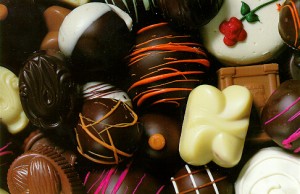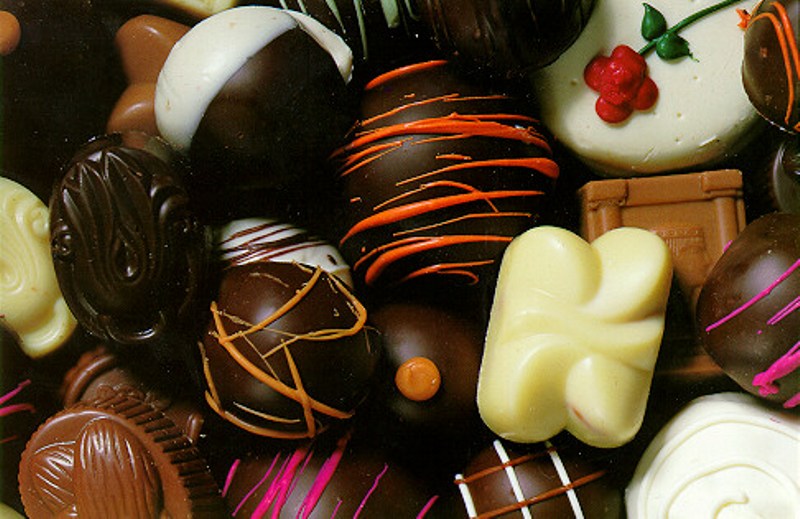CHOCOLATE has always been inspiration to numerous artists, poets, and writers evoking not only carefree childhood, but passion and love  too. The film Chocolate (Chocolat), starring Juliette Binoche and Johnny Depp, deals with the universal language of savouring the sweet tooth. There are so many songs inspired by chocolate such as Chocolate, by the world-famous Australian pop-artist Kylie Minogue, then You Are My Chocolate (orig. ‘Ti Si Moja Čokolada’) by a Belgrade band Idoli (Idols), followed by Strawberries and Chocolate (orig. ‘Jagode i čokolada’) by a Croatian singer, Neno Belan & a band from Split Đavoli (Devils) which we hum every day and that’s another way we let chocolate in our everyday lives. When we wish to escape reality and stress for a tiny moment, there’s always a piece of chocolate, or a recently popular hot chocolate massage. Chocolate is a fine gift at any time and when we want to show our class and style an out-of-ordinary or exclusive wrapping is always a good choice. At work, while we sit at the computer with heaps of reports and work to be done quickly, nothing is going to boost our so much needed concentration as a chocolate bar.
too. The film Chocolate (Chocolat), starring Juliette Binoche and Johnny Depp, deals with the universal language of savouring the sweet tooth. There are so many songs inspired by chocolate such as Chocolate, by the world-famous Australian pop-artist Kylie Minogue, then You Are My Chocolate (orig. ‘Ti Si Moja Čokolada’) by a Belgrade band Idoli (Idols), followed by Strawberries and Chocolate (orig. ‘Jagode i čokolada’) by a Croatian singer, Neno Belan & a band from Split Đavoli (Devils) which we hum every day and that’s another way we let chocolate in our everyday lives. When we wish to escape reality and stress for a tiny moment, there’s always a piece of chocolate, or a recently popular hot chocolate massage. Chocolate is a fine gift at any time and when we want to show our class and style an out-of-ordinary or exclusive wrapping is always a good choice. At work, while we sit at the computer with heaps of reports and work to be done quickly, nothing is going to boost our so much needed concentration as a chocolate bar.
The history of chocolate is long and extensive as all the big stories that have created the world as we know it. There is archaeological evidence that 2600 years ago chocolate mass cooked in Olmeca, making chocolate one of the most ancient beverages known to man. The people of this ancient civilization believed that the cocoa tree belonged to gods, and that its fruit is the gods’ gift to people. Later on, in the Aztec culture, the magical cocoa potion could be enjoyed by the priests and nobles only. It was believed then that the chocolate beverage instilled wisdom and power, so it was regularly used in religious rituals too. Before a battle, warriors also drank this beverage as they believed that it would give them the divine power and resilience. Centuries after, the divine warrior potion was turned into a sweet by Europeans, forever changing the achievements of the modern civilization.
Today, a must see venue when visiting a city is for sure a chocolate museum. Most major capitals list in their city to urs the visit to such museums. Here is the list of five best museums worldwide, which will meet the strictest criteria:
urs the visit to such museums. Here is the list of five best museums worldwide, which will meet the strictest criteria:
1. The Chocolate Museum, Cologne, Germany
2. Musee les Secrets du Chocolat, Geispolsheim, France
3. Pannys Amazing World of Chocolate, Victoria, Canada
4. Choco-Story Chocolate Museum, Bruges, Belgium
5. Museu de la Xocolata, Barcelona, Spain
The production of chocolate is a fascinating process taking you on a tour from magnificent tropical forests to modern plants. To turn the cocoa bean into chocolate takes a lot of time, effort and art. The cocoa tree fruit, egg-shaped and weighing around 750 grams, contains around 30-40 beans. The beans are collected, piled on the ground and covered by banana leaves. This procedure is known as fragmentation and lasts 2 to 3 days, when the beans are being turned several times. Then, the beans are cleaned from husks and dried in the sun for two weeks. Such dried beans are picked out and they have to be perfectly clean. After that, they are baked at 120 – 130 degrees for 15 to 35  minutes. The beans are then crushed, sieved and sorted by size, removing the remaining husks in the process. Crushed cocoa beans get ground on the millstone and turned into a thick mass, moving on to hydraulic pressing to be released from excess fat and finally result in cocoa powder. Cocoa bean fat content is 54%, and by its removal we get low-fat chocolate varieties, but if necessary, the removed fat better-known as cocoa butter may be added to cocoa powder. Such prepared mass is cleaned once again from larger cocoa solids in a special device making cylindrical rotations at an extremely high speed. Then, depending on a recipe, cocoa powder may be commonly added with ingredients such as sugar, milk, cocoa butter, vanilla, etc. The clean mass obtained is heated at 32 C and then cooled gradually under control. Depending on cocoa powder content, chocolate may be dark including 60-80% of cocoa powder, semi-dark with 50% and milk chocolate with 30% of cocoa powder.
minutes. The beans are then crushed, sieved and sorted by size, removing the remaining husks in the process. Crushed cocoa beans get ground on the millstone and turned into a thick mass, moving on to hydraulic pressing to be released from excess fat and finally result in cocoa powder. Cocoa bean fat content is 54%, and by its removal we get low-fat chocolate varieties, but if necessary, the removed fat better-known as cocoa butter may be added to cocoa powder. Such prepared mass is cleaned once again from larger cocoa solids in a special device making cylindrical rotations at an extremely high speed. Then, depending on a recipe, cocoa powder may be commonly added with ingredients such as sugar, milk, cocoa butter, vanilla, etc. The clean mass obtained is heated at 32 C and then cooled gradually under control. Depending on cocoa powder content, chocolate may be dark including 60-80% of cocoa powder, semi-dark with 50% and milk chocolate with 30% of cocoa powder.
For the original interactive application on chocolate making developed by The Field Museum, Chicago, please visit the link below
http://archive.fieldmuseum.org/chocolate/manufacture_interactive/manufacture.html
MEDICINE & CHOCOLATE
The eternal dilemma bothering the chocolate lovers goes like this: Is it only a cause of overweight or it has benefits too? Has the medicine, seeking the excuse for eating this fantastic sweet, gone far enough to prove that chocolate is in fact healthy?
Some research has showed that moderate daily intake of chocolate (7.4 grams per day) reduces the threat of stroke by 48%, and heart attack by 27%. Namely, German research conducted on a sample of 20,000 people for 8 years showed that the effect could be higher with the daily intake of 10 or even 20 grams of chocolate daily. The scientists state that reduced threat of heart attack and stroke is pertinent to lowered blood pressure in chocolate eaters, since it is a foodstuff reach in highly beneficial antioxidants, polyphenols, abundantly present in dark chocolate which has a high cocoa content.
Some of the recent findings show that cocoa contains antibacterial strains slowing down tooth decay, then that chocolate acts as an excellent  tranquiliser, that chocolate is particularly rich in minerals such as phosphorus, magnesium, iron, and zinc and it also contains some B-group vitamins, vitamin E and beta-carotene.
tranquiliser, that chocolate is particularly rich in minerals such as phosphorus, magnesium, iron, and zinc and it also contains some B-group vitamins, vitamin E and beta-carotene.
Chocolate contains substances which induce the release of serotonin and dopamine in the brain, that is, the neurotransmitters causing the feeling of joy. Alkaloids, theobromine and caffeine, contained in chocolate, not only do they restore the good mood but they also tighten the skin. Facial creams and masks conceal chocolate extracts, in the first place due to the antioxidant effect of polyphenol which binds free radicals produced by UV rays or nicotine and so protects the skin. In addition, a study proves that it improves the skin texture and that it can keep it hydrated.
And concerning the permanent dilemma about chocolate pros and cons, scientists have, nonetheless, come to this simple conclusion: If you eat chocolate three times a month (every ten days), you will live at least a year longer than those who are not chocolate lovers.







































 Srpski
Srpski English
English